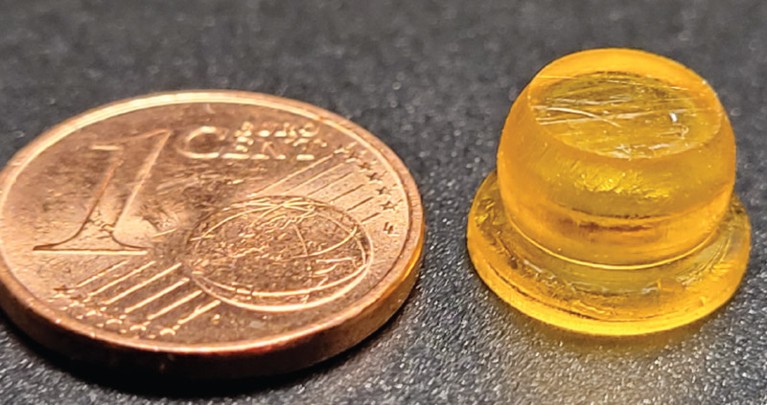Researchers have designed sticky patches inspired by octopus suckers that can deliver difficult-to-absorb drugs through a person’s inner cheek.
The small suction cups are made of rubber and could offer friendlier way to deliver intravenous drugs, including hormones such as insulin and the blockbuster drug Ozempic, as well as medicines that degrade as they travel down the digestive tract.
The cups were better than commercial oral tablets in delivering an antidiuretic medication called desmopressin into the bloodstream of dogs, and were preferred by people over injections in a small trial. The team describes1 its technique in Science Translational Medicine on 27 September.
“This clever way of overcoming biological barriers will inspire other drug-delivery scientists to improve further so that, someday, we can deliver insulin non-invasively,” says Kinam Park, a pharmacist at Purdue University in West Lafayette, Indiana.
Sticking problem
Table of Contents
Large-molecule drugs made of peptides or proteins are difficult to absorb and often have low oral bioavailability, meaning that only a small proportion of the medicine taken by mouth reaches the bloodstream. Most of these drugs are administrated through injections.
Researchers have sought non-invasive approaches to deliver peptides, such as patches that adhere to the mouth’s lining. But getting substances to stick to wet cheeks without damaging the tissues can be difficult.
Materials scientist Zhi Luo at the Southern University of Science and Technology in Shenzhen, China, and his colleagues took inspiration from the suction cups that octopuses use to grip objects and prey underwater. They rubber versions that measure about 1.1 centimetres across and 0.6 centimetres high, with a small chamber that holds more than 60 milligrams of a drug and stops the medicine being diluted by saliva or other fluids, says Luo.

The rubber suction cups are filled with medication and then stuck to the inner cheek.Credit: ETH Zurich
The cups also stretched the inner mouth tissue by up to 285%, increasing the surface area through which drugs can penetrate. The researchers tested the patches in beagles, which have a similar cheek lining to humans. They loaded the cups with 1.2 milligrams of desmopressin and 2.1 milligrams of a chemical that enhances drug permeability through tissues.
Desmopressin is one of only a few peptide drugs that is administered orally. When given through the suction cups, its bioavailability increased from 0.12% to 16.4%. After 3 hours, the dogs who used the suction cups had a blood plasma concentration of the drug that was 150 times higher than the dogs who took tablets. This is an “unprecedented increase in bioavailability,” says Simon Matoori, clinical pharmacist at the University of Montreal in Canada..
When the authors reduced the application time to 10 minutes, the oral bioavailability remained significantly higher, at 3.2%, than that of the tablets.
The researchers also tested the patches with the diabetes and weight-loss drug semaglutide — known as Rybelsus in oral form or Ozempic in injectable form — the molecules of which are four times larger than desmopressin. After 30 minutes, the patches had similar bioavailability to tablets.
In a 40-person human trial, participants self-applied patches that contained water for 30 minutes. Three-quarters said that they felt comfortable after removing them. Most participants — 83% and 90% — preferred the patches over needle injections for daily and weekly use, respectively, after the trial.
“Long term toxicity studies of the drug and permeation-enhancer-loaded suction patch will determine the true potential of the system,” says Matoori.
Better for kids
There are many drugs that could be delivered using the approach instead of injections — or whose development might be hampered by the requirement to administer them intravenously, says Jean-Christophe Leroux, a pharmacist at Swiss Federal Institute of Technology in Zurich (ETH Zürich), Switzerland, and study co-author.
The technology could apply to the plethora of drugs that are being investigated or approved for diabetes or obesity that need to be injected. “These drugs could be good candidates,” says Leroux.
“The biggest problem with insulin is the degradation in the gastrointestinal tract, which can be minimized thanks to this suction patch,” says Matoori.
Children who require regular injections of medications could also benefit. “If we can switch injectable growth hormones to patches, I think kids would be really happy,” says Luo.
